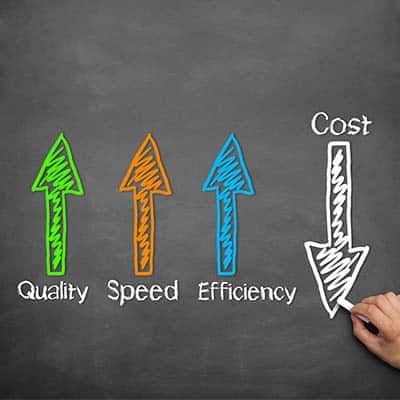Optimize Your Apps How many applications do you currently have installed on your phone? Of those, how many do you actually use? Chances are, there are a lot of apps that no longer serve you any purpose that are just sitting on your phone, cluttering your application drawer and drawing attention away from the tools you need. Our recommendation here is twofold: first, do some spring cleaning and delete some of the applications that you just don’t use any longer. They aren’t doing you any good, anyway, and they are only taking up valuable storage space on your device. Second, take the time to organize your device, arranging apps on different screens. This will help you to stay focused on the task and hand, without your social media accounts or the silly mobile game you downloaded drawing you away – there is nothing wrong with having them, as long as they don’t impact your work. Disable Certain Notifications Speaking of your social media (and of being drawn away from your responsibilities, for that matter), there is no need that you need to know that one guy you met at a mutual friend’s party has liked your status during work hours. The same goes for the silly mobile games. Who cares that your energy has recharged and that “your kingdom needs you?” You have real work to do! The notifications that these applications send us are meant to be disruptive, to put the task at hand to the side as you follow the application where it takes you. Turning off notifications takes a lot of power away from distracting applications simply by preventing temptation. Disconnect Depending on the task at hand, it may even be a good idea to disconnect your phone for a few moments’ peace. Of course, if you’re expecting important phone calls to be coming in, this is a bad strategy to try out. Otherwise, kill your phone’s Internet and wireless connections, and consider putting on some headphones to make your focused attention clear to anyone around you. Keep It Updated Of course, for your mobile device to be able to work productively, its software needs to be vetted and maintained. Make sure you actively apply updates and patches over time to ensure that your device remains in good working order. Your IT resource will be a useful ally to lean on where this is concerned. What has your experience been with smartphones in the workplace? Share your thoughts in the comments!
Let’s begin by defining what a CRM strategy really is, which will help to illustrate why it matters. The Concept of a CRM Strategy Using CRM software has a pretty low bar for entry. Basically, you just have to procure it and populate it with the data you have collected. The purpose of a CRM strategy is to really use your solution to the fullest extent that you can, which allows you to optimize your outcomes. There are a few ways that your CRM strategy can enable you to do so: It condenses data in context to help you reference it as you make decisions and set goals. It makes customer service efforts more comprehensive, which can boost retention and loyalty. It assists you in making sales by scaling your process properly and eliminating redundancy. Naturally, these are benefits that can assist any business in its pursuit of its goals, so it is important that you create a proper CRM strategy to guide you. Here is a simple process for you to follow: Understand Your Goals and Strategize For ThemWhat is it, exactly, that you want your business to accomplish? What is your intended use of your CRM software, and what do you want to achieve with it? How will each department use it to do strive toward their goals? How will your offering be distributed? Once you have conferred with your team and answered these questions, it is time to consider the business landscape and who your ideal clients are. Then, determine what makes your offer different, and commit to providing this difference each time in the way that best suits your prospects. Analyze and Organize Your TeamHow will the introduction of your new CRM software impact your team? Speak with those whose job responsibilities will be affected by your new solution, and look for any past experience with such platforms for their impression of different options. You will also need to identify those team members who will be using the software to collaborate and be sure that everyone understands their particular roles. It is also helpful to determine the goals that each department should strive toward, and identify the key performance indicators that will help measure their progress. Implementing Your New Solution and StrategyDetermine how different contacts will be divided within your CRM, and establish a policy of collecting all the information you need from a contact that is going to be included. You should also strongly consider mapping out your sales processes for each of your services so it is easier to manage your brewing business. It is also a good idea to keep your software requirements in mind when selecting your CRM, as you will want to select a title that plays nicely with your existing solution. Is your chosen email platform Outlook? Make sure to find a CRM that integrates with it for optimal benefits. SRS Networks is here to help you with these considerations, and more. To learn what we can do to assist your customer relationship management through IT solutions, or any other of your business processes, reach out to us at (831) 758-3636.
Gamification of Business Tasks Gamification is widely used in parenting to convince children to cooperate on things that may nor be in their best interests. As a business owner or decision maker, your employees come to work with their own expectations. To enhance those expectations, gamifying tasks may be just the thing your business needs to take operations to the next level. The psychology of gamification is that of making even trivial tasks seem important by presenting them as a competition. If this doesn’t sound realistic, consider the concept of “employee of the month.” Why Gamification is Effective Human psychology is a big part of why gamification has an impact. As a species, human beings tend to be strongly motivated by certain desires, namely: Recognition – I want my efforts to be paid attention to. Competition – I want to win. Distinction – I want to be rewarded for my efforts. Inherently, most tasks at work don’t carry anything but negative feedback. By gamifying even the most menial task, it injects the capability of fulfillment. Employees will be more driven if they a) think they are competing against their work “rivals” and b) if they think they can get the recognition of being superior. As long as the incentives continue, you can expect that these workers will be more driven to accomplish better work than without those incentives. Adopting Gamification If you are considering gamifying your more rote tasks, you have a lot of options in which to do so. Sure, different tasks, different workflows, and different industries will have different things they can do to jazz up workplace competition, but choosing how to accomplish this (i.e. what the game is), and what incentives there will be as rewards is all up to you. Do you think that gamification will work for you? Leave your thoughts and suggestions in the comments section below.
What is Automation? Every office has those menial tasks that nobody wants to take the time to do, but really need to be done at some point. Fortunately, as technology has advanced, so has the capability for these tasks to be completed with minimal human engagement. Automation (technically, business process automation) is simply the use of technology to simplify and minimize the amount of work and attention your human resources need to contribute in order to reach an objective. As automation has received a bit of a bad break as a job killer, it is important to clarify that the kind of automation we generally talk about is intended to lighten the rote responsibilities of your employees, freeing their time to focus on other, more productive tasks and concerns. When used in this way, business process automation can help boost your employees’ job satisfaction, consistency, and efficiency (although the job-killing reputation that automation has garnered might lead to some resistance at first). Not sure how you might put it to use in your operations? We have a few suggestions that you may find intriguing. How to Leverage Automation When all is said and done, automation could conceivably assist with any task. However, we want to focus on the ways that will really provide your business with the most value, so mull over some of these applications (again, just some of your potential opportunities). Customer SupportHow much time is spent answering calls, or emails, or Facebook messages, all asking precisely the same question? Chances are, too much. That’s why many automated customer support options are so useful – they give you an alternative way to provide support that can often resolve your contact’s quandary without involving you or your employees. This kind of vetting reserves your employees’ attention to issues that really require it. ComplianceMany industries are subject to assorted requirements that concern different aspects of their operations, passed down by the government or by the industry itself. Automation allows you to set procedures that meet the prescribed guidelines to appease regulators, saving you from further trouble and effort later. CommunicationThere are a lot of moving parts involved in any business (especially if automation is put in use), so there are going to be certain people who need to be kept in-the-know. These people may be internal resources, or operate outside of the business. This even includes clients and customers. Regardless, automation can help ensure that there is always clear communication, without anyone having to remember to send a message. Naturally, there are far more ways that your business’ operations could be automated behind-the-scenes, so don’t hesitate to reach out to us and discuss what your options might be! Our professionals are here to help. Call (831) 758-3636 today.
Now, to literally become more organized, you’ll need to better manage your documents, keeping your workspace clean (and, of course, motivating your crew to do the same). On the abstract side, we’re describing all of the digital storage and tools that can help you keep your business on track. Let’s dive in, starting with the literal. Managing Your Documents While paperless offices are increasing in popularity, you may have business-related reasons to continue keeping paper copies of things, along with other kinds of documents that are generated as hard copies by their nature. This includes things like handouts, business cards, and quickly-jotted-down notes. This situation makes a document management system a worthwhile investment, so that once you’ve sorted through your collected documents, you can move forward with a better option for organizing them. Cloud solutions are a good place to store digital files, as they allow controlled collaboration with those who need access to certain files and resources. You may also want to reconsider if a paperless system would work for you. Many of the reasons that hardcopies were once necessary are now able to be attended to digitally – like collecting signatures, organizing receipts, even retaining business cards. Working in the Right Space While we’re working on reducing the paper clutter in the office, keep in mind that an organized workspace can provide significant boosts to productivity. Encourage your users to minimize distractions on their desk – but don’t ban any personalization, either, unless it would be inappropriate for other reasons. While organization is easier with less to occupy a given space, some level of personalization can help an employee stay engaged, and less like they are in a bubble. In order to better organize a workspace, encourage your employees to manage things as they go, rather than letting items or documents stack up in a “to-do” pile. Each thing on their desk should also have a set place to be, allowing them to more quickly find what it is that they need – contributing to fewer impacts upon their focus. Use Various Business Organization Tools There are many different solutions that, as we briefly referenced above, can help you to digitize and organize your assorted resources and files. These include: Contact Management – Rather than the antiquated Rolodex or address book, there are software titles that make it simpler to manage your contacts. A comprehensive customer relationship management solution can fulfill this need, as well as many others. Accounting and Bookkeeping – A business’ cash flow is critical to its success, and the more organized it is, the less likely it is that mistakes will be made. With options to assist your invoicing, payment acceptance, and cash flow management, we can help you here. Communication – A big part of organization is the ability to communicate with the rest of your team regarding where different things are, as well as their status. From email platforms, instant messaging solutions, and project management solutions, there are various means of encouraging this kind of communication. Organizing your business can be much simpler than it sounds, especially with SRS Networks helping you. Reach out to us at (831) 758-3636 for more!
Improved Customer Service Regardless of whether you operate in the B2C or B2B space, you need to be sure that your clients/customers are satisfied with the products, services, and experience you provide them. The IoT can help improve these. Whether you follow the lead of some grocery stores, and outfit shopping carts with displays that offer recipe suggestions based on the shopper’s proximity to certain ingredients, or you work in distribution, leveraging smart trackers to enable your customers to check the progress of their purchases – there is effectively no limit to the ways that the IoT can be leveraged to benefit your target, and the more satisfied they are, the more likely they are to return to your services. Increased Productivity A business that, for whatever reason, can’t operate productively is one that isn’t going to be around for very long. There are a few ways that the IoT can help to boost the inherent productivity of a business. For instance, by using the IoT to monitor their supply levels throughout a production run, manufacturers can use the IoT to make educated predictions based on historical data – and that’s just one, very specific example. There are many other ways to boost productivity with the IoT’s support. Critical tasks and meetings can be scheduled around the times that IoT solutions record high levels of productivity, and rote tasks can be automated through IoT devices so employee time can be spent more wisely. A Safer Work Environment In higher-risk workplaces, the IoT can be used to help better ensure the safety of the employees you have on the job. Consider those who work in construction – wearables could be used to keep track of them on the worksite. Offices can be made more secure with video surveillance and connected smart locks to help control access. However, it is important to acknowledge that the IoT is still pretty unstandardized when it comes to its own security. This is why you will want to work with a provider like SRS Networks to ensure you aren’t trading your organizational security for (most likely short-lived) productivity. Streamlined Costs Let’s touch back on productivity once again, and discuss how some of the same capabilities can help decrease your overall operational costs. We mentioned how there are some tasks that can be automated through the IoT, but what we haven’t mentioned yet is how doing so can help save you some capital to invest elsewhere. Think about it: by automating tasks, you are eliminating the need for one of your employees to take the time and complete those same tasks. Therefore, not only are these tasks completed more efficiently, but your employees can take the time they would have spent on them to accomplish other things – effectively doubling your output. Greater Data Insights Finally, the Internet of Things can be a great tool to help you collect crucial business metrics and other data samples to leverage toward improving your operations. Whether you use the historical data you have collected through the IoT to build a predictive model, build customer profiles, or solve your other challenges, the IoT is a hugely beneficial resource to harness. While there are still some security concerns to the IoT, SRS Networks can help you select and secure solutions that will […]
Better Technology Makes You More Relevant – and Thereby, Competitive How would you feel if you walked into a financial planner’s office for assistance with your business’ budget and saw all of the employees working diligently at their desks, each making calculations with an abacus? Or if you were in the hospital for a procedure, and your anesthetist pulled out a mallet to prepare you for surgery? Presumably, you’d leave. While these are extreme examples, the same concept goes for any business. Technology is developed to improve workplace operations, making operations more efficient, more reliable, or more effective – if not some combination of the three. Failing to keep up with these improvements, as your competition does, will only put your business further behind the curve – making it harder to attract the clients and customers you need to maintain your revenue streams. It also doesn’t hurt that the majority of people you are trying to attract to your business are looking for a provider that can outperform the competition – something that you cannot do if they are utilizing the latest and greatest solutions when you aren’t. Today, your hope is that the opposite situation is the case – your solutions being better than theirs. Technology Can Boost Efficiency For the sake of your business’ budget, its aforementioned relevance, the overall satisfaction level of your clientele, and a variety of other key factors… your business needs to operate efficiently. The longer your operations take, the more expensive they will prove to be for your business, and the less satisfied your clientele will become – again, especially if they are comparing you to an alternative provider. There are many ways that IT solutions can prove to be a benefit in this way. Automation can reduce the amount of time your employees spend trudging through rote tasks, freeing up quite a bit of time in any department. As a result, these tasks can be completed with machine accuracy, while your employees can simultaneously be productive towards their goals and objectives. There’s Improved Security Potential in Technology You may have picked up on how a lot of cybersecurity threats now rely on the inherent vulnerability of human beings, with phishing attacks and ransomware being such popular means of attack. Why is this the case? Well, technology has improved to the point where it is often easier to take advantage of the user than it is to breach the system – assuming that the system in question has the proper safeguards implemented. While it obviously can’t be said that these safeguards will always keep your business’ data safe, there is a definite increase in the frequency of cyberattacks that target user vulnerabilities, rather than software ones. In fact, according to a survey that the Small Business Trends website maintains, phishing and social engineering were experienced by 43 percent of their respondents. According to some sources, a full 76 percent of businesses reported being the victims of a phishing attack in 2018. Why is this? Well, to be frank, many cybercriminals are reconsidering how their attacks should take shape as security solutions have improved. If the weakest point in a business’ security is the user, it makes more sense to target the user. While this means that any business needs to seriously consider training […]
Communications Considering that these devices are still technically telephones, it should be no wonder that communication is big in a smartphone – and that’s before we even consider their capacity to surf the Internet and send messages. These multipurpose communication tools can keep your team on the same page, collaborating efficiently and effectively. Mobile Applications Many mobile applications can be leveraged by your employees to continue their productivity, whether or not they are in your place of business. This mobility helps deliver value to your enterprise, as web-based resources accessed through a desktop’s browser were once the only real option for a worker to leverage. Mobile apps augment the opportunity for an employee to accomplish their goals. Utilizing mobile apps has become such a common business practice that many applications used by organizations have had mobile versions developed. As a result, your employees can more successfully collaborate with each other, as well as deliver the products and services you offer more efficiently. Therefore, operations and support are improved. Presumed Detriments Despite these benefits, many employers aren’t completely sold on encouraging smartphone use in the workplace. This makes some sense, as they could presumably become a bigger distraction than they are a benefit, hurting the business. Similar things are often said about social media. Many businesses have gone so far as to forbid the use of smartphones during work hours, their reasoning being that the more time spent on smartphones is equal to less time spent on their business. This reasoning has a few holes in it. The biggest one being the unsupported assumption that time equals productivity, which isn’t necessarily the case. Furthermore, this doesn’t account for the time that a smartphone could be used to the benefit of the business outside of normal working hours. BYOD and Mobile Device Management Of course, with businesses allowing smartphones to be leveraged, they need a way to make sure these devices are properly managed. Some businesses can provide their employees with company smartphones, but many just can’t afford to do that. This doesn’t leave these companies out of luck, however… the combination of mobile device management software and a policy known as a Bring Your Own Device (or BYOD) policy allows these businesses to oversee each device that connects to their network. Depending on the policy, this can cover only the applications and data that the company requires/controls, while others extend to the entire device. These platforms enable administrators to retain control over the wireless network, enforcing permissions and keeping the company’s data secure. Think of it as a content filtering system that works on your employees’ devices, whitelisting and blacklisting applications that serve company purposes or serve as distractions, respectively. SRS Networks can help you leverage the capabilities of a mobile device in your business. For assistance in implementing mobile device management, reach out to us at (831) 758-3636.
Applying Tags OneNote features a set of preconfigured tags that can add additional context to your notes. By default, pressing Ctrl+1 adds a checkbox, allowing you to create a simple to-do list. Other shortcuts can add other tags, like Ctrl+2 adding a star, or Ctrl+3 adding a question mark. You can also customize these tags and reassign these shortcuts. If using OneNote Desktop 2016, all you have to do is access the Home tab and select Customize Tabs. From there, you can add new tags and reorder them so the ones you will use most often are in the top nine, and accessible via keyboard shortcuts. Embedding Files If you need to be sure that you can access a particular file, especially in the context of one of your projects, OneNote offers a useful tool in its capability to embed files into the notes you take. Once you’ve activated the Store attachments in cloud option (found in Settings > Options in Microsoft Outlook) any file you attach to a OneNote page from Outlook is also uploaded to OneDrive and linked to with a live preview. Creating Subpages After you’ve used OneNote for a while, there’s a good chance that your notes will become somewhat difficult to manage. Using subpages to create a hierarchy can make this a lot easier – and organizing your notes is super simple. All you have to do to turn one of your pages into a subpage is to click and drag it under the page you want it associated with, then dragging it right to indent the title. A/V Capture When your notes need that added touch of context, OneNote’s ability to record and incorporate audio and video becomes particularly handy. By clicking Insert and then selecting either Audio or Video, the selected media type will automatically begin recording. Once you’re satisfied with what you’ve captured, you can stop the recording by pressing Stop on the Audio & Video tab. Content Search Again, once you’ve used OneNote for a while, you’re apt to accumulate quite a few notes – enough to make it challenging to find something specific. To simplify things, OneNote offers a built-in search function that allows you to scan your notebooks for the word or phrase you are trying to find, greatly simplifying the process of finding what you need. What other OneNote tips do you know about? Share them in the comments!









